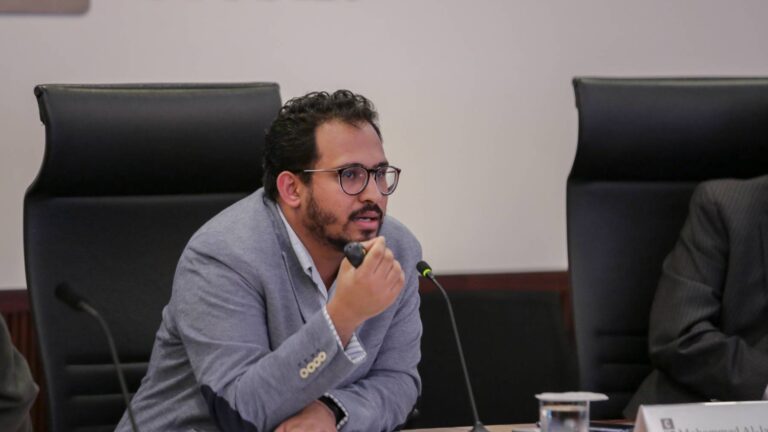Regional Studies, Student Engagement
The Marib Puzzle: A Case of Stability and Economic Activity in War-Torn Yemen

Mohammed Al-Jaberi, a GU-Q senior majoring in Foreign Service and Arab Studies, and a CURA Publications Fellow, presented his research on “The Marib Puzzle: A Case of Stability and Economic Activity in War-Torn Yemen,” at a CURA Focused Discussion on April 3, 2019. Al-Jaberi, a citizen of Yemen, returned to his country this past year to conduct research towards his academic thesis in which he addresses the complexity of the war in Yemen, the political symbolism of the city of Marib, and the war’s sociocultural and political impacts on the country.
Focusing his study at the local level, Al-Jaberi examined two cities: the port city of Aden, and the city of Marib in the center of Yemen. His primary research question was: “Why does Marib have more stability and economic activity compared to the temporary capital, Aden?” Al-Jaberi defined “stability” as the absence of local conflict, sustainable access to public goods and services, and the resilience of the local government. In order to answer the central research question, he examined trade, commercial activities (semi- and fully-legal), and the money injected into Yemen by coalition forces—especially Saudi Arabia and the United Arab Emirates.
Giving background to when the ongoing war in Yemen began, Al-Jaberi argued that there are two significant and contested dates: September 21, 2014, is when Houthi rebels took over the capital city of Sana‘a and overthrew President Hadi; and March 25, 2015, is when Saudi Arabia intervened militarily with a coalition force in Yemen. Coalition supporters assert that the war began on the former date, whereas Houthi rebels deny that the conflict is actually a civil war, claiming that it is a Saudi-led aggression. The answer to this debate, Al-Jaberi said, depends on how one classifies the current conflict, and he posed the following questions: “Is it a civil war? Is it a transnational aggression? Should we blame Saudi Arabia for it? Should we blame the Houthis?” Thus, he attempted to address the widespread tendency to oversimplify the war in Yemen by framing it in terms of only two sides.
“Corruption, poverty, patronage networks, the absence of a meaningful nation-state, and the fragility of the system have all compromised Yemen’s current standing.”
Al-Jaberi identified three major causes of the war: the failure of a transitional process after the 2011 Arab uprisings; the inability to resolve historical grievances in terms of North and South Yemen; and Yemen’s limited role in the international community. “Corruption, poverty, patronage networks, the absence of a meaningful nation-state, and the fragility of the system have all compromised Yemen’s current standing,” he said. Because of these issues, “Yemen has become a playground for international powers to exercise their influence and to enact their hegemony,” Al-Jaberi argued.
The reality in Yemen today is its division into three different states: the Sana‘a area is under Houthi control; Aden and the south are controlled by the UAE and its affiliated forces; and “the ‘Marib state’ is a center that contains political actors within President Hadi’s camp who want to maintain a unified Yemen,” Al-Jaberi argued. Of these three states, the literature, media coverage of the war, and the behaviors and actions of foreign delegations visiting the country conclude that Marib appears to be the only stable region in the country, he said. Though interviews, analyses, and time spent in Yemen, however, Al-Jaberi said, “I found that stability, and stable economic activity, in the two regions of Aden and Marib was not absolute, but a matter of relative reality.” The war in Yemen has become normalized, and is a “lucrative business,” he said.
Al-Jaberi concluded by highlighting the two outcomes of his research. He argued that stability in Yemen is being directly affected by two different systems: patronage networks operating in Marib, on the one hand, and the UAE and Saudi Arabia operating in Aden, on the other. The first concerns the shift from the historical center of Yemen—the capital Sana‘a—to Marib. He argued that this was not an example of successful local governance; rather, it is due to historical political elites “with their tribal, military, religious, technocratic connections” maintaining power by shifting to a different city. Those who operate and control the government of President Hadi “are part of a network of patronage that controls everything,” Al-Jaberi said. Thus, the increase of economic activity in Marib is due to redirecting resources, rather than the actual creation of new businesses. The second concerns how the economy of Yemen is being further politicized by the discrepancies between how the South is being influenced by UAE, and how the North is being influenced by the Saudi Arabian monarchy.
Article by Khushboo Shah, CURA Administrative Fellow
Mohammed Al-Jaberi (class of 2019) is graduating from Georgetown University in Qatar with a B.S. in Foreign Service and M.A. in Arab Studies. His research interests revolve around development, state-building, and political Islam. He is currently working on a documentary film on the economic and personal struggles of young participants of war in Aden. In addition to his role as a CURA Publications Fellow at CIRS since 2016, he has held internships at Teach for Qatar, the United States Embassy in Doha, and Qatar Foundation.